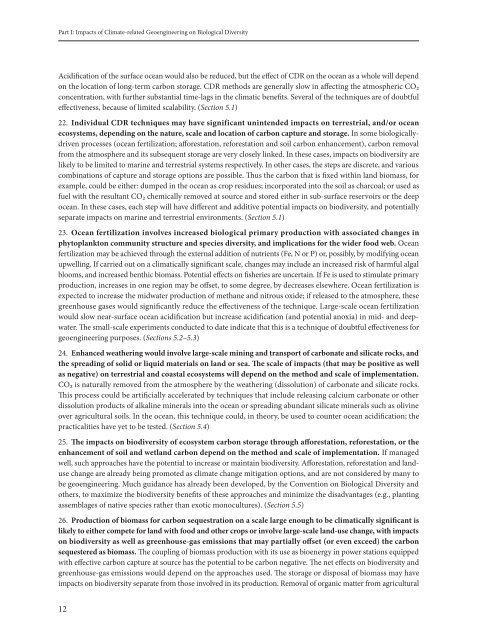cbd-ts-66-en
cbd-ts-66-en
cbd-ts-66-en
You also want an ePaper? Increase the reach of your titles
YUMPU automatically turns print PDFs into web optimized ePapers that Google loves.
Part I: Impac<strong>ts</strong> of Climate-related Geo<strong>en</strong>gineering on Biological Diversity<br />
Acidification of the surface ocean would also be reduced, but the effect of CDR on the ocean as a whole will dep<strong>en</strong>d<br />
on the location of long-term carbon storage. CDR methods are g<strong>en</strong>erally slow in affecting the atmospheric CO2<br />
conc<strong>en</strong>tration, with further substantial time-lags in the climatic b<strong>en</strong>efi<strong>ts</strong>. Several of the techniques are of doubtful<br />
effectiv<strong>en</strong>ess, because of limited scalability. (Section 5.1)<br />
22. Individual CDR techniques may have significant unint<strong>en</strong>ded impac<strong>ts</strong> on terrestrial, and/or ocean<br />
ecosystems, dep<strong>en</strong>ding on the nature, scale and location of carbon capture and storage. In some biologicallydriv<strong>en</strong><br />
processes (ocean fertilization; afforestation, reforestation and soil carbon <strong>en</strong>hancem<strong>en</strong>t), carbon removal<br />
from the atmosphere and i<strong>ts</strong> subsequ<strong>en</strong>t storage are very closely linked. In these cases, impac<strong>ts</strong> on biodiversity are<br />
likely to be limited to marine and terrestrial systems respectively. In other cases, the steps are discrete, and various<br />
combinations of capture and storage options are possible. Thus the carbon that is fixed within land biomass, for<br />
example, could be either: dumped in the ocean as crop residues; incorporated into the soil as charcoal; or used as<br />
fuel with the resultant CO2 chemically removed at source and stored either in sub-surface reservoirs or the deep<br />
ocean. In these cases, each step will have differ<strong>en</strong>t and additive pot<strong>en</strong>tial impac<strong>ts</strong> on biodiversity, and pot<strong>en</strong>tially<br />
separate impac<strong>ts</strong> on marine and terrestrial <strong>en</strong>vironm<strong>en</strong><strong>ts</strong>. (Section 5.1)<br />
23. Ocean fertilization involves increased biological primary production with associated changes in<br />
phytoplankton community structure and species diversity, and implications for the wider food web. Ocean<br />
fertilization may be achieved through the external addition of nutri<strong>en</strong><strong>ts</strong> (Fe, N or P) or, possibly, by modifying ocean<br />
upwelling. If carried out on a climatically significant scale, changes may include an increased risk of harmful algal<br />
blooms, and increased b<strong>en</strong>thic biomass. Pot<strong>en</strong>tial effec<strong>ts</strong> on fisheries are uncertain. If Fe is used to stimulate primary<br />
production, increases in one region may be offset, to some degree, by decreases elsewhere. Ocean fertilization is<br />
expected to increase the midwater production of methane and nitrous oxide; if released to the atmosphere, these<br />
gre<strong>en</strong>house gases would significantly reduce the effectiv<strong>en</strong>ess of the technique. Large-scale ocean fertilization<br />
would slow near-surface ocean acidification but increase acidification (and pot<strong>en</strong>tial anoxia) in mid- and deepwater.<br />
The small-scale experim<strong>en</strong><strong>ts</strong> conducted to date indicate that this is a technique of doubtful effectiv<strong>en</strong>ess for<br />
geo<strong>en</strong>gineering purposes. (Sections 5.2–5.3)<br />
24. Enhanced weathering would involve large-scale mining and transport of carbonate and silicate rocks, and<br />
the spreading of solid or liquid materials on land or sea. The scale of impac<strong>ts</strong> (that may be positive as well<br />
as negative) on terrestrial and coastal ecosystems will dep<strong>en</strong>d on the method and scale of implem<strong>en</strong>tation.<br />
CO2 is naturally removed from the atmosphere by the weathering (dissolution) of carbonate and silicate rocks.<br />
This process could be artificially accelerated by techniques that include releasing calcium carbonate or other<br />
dissolution produc<strong>ts</strong> of alkaline minerals into the ocean or spreading abundant silicate minerals such as olivine<br />
over agricultural soils. In the ocean, this technique could, in theory, be used to counter ocean acidification; the<br />
practicalities have yet to be tested. (Section 5.4)<br />
25. The impac<strong>ts</strong> on biodiversity of ecosystem carbon storage through afforestation, reforestation, or the<br />
<strong>en</strong>hancem<strong>en</strong>t of soil and wetland carbon dep<strong>en</strong>d on the method and scale of implem<strong>en</strong>tation. If managed<br />
well, such approaches have the pot<strong>en</strong>tial to increase or maintain biodiversity. Afforestation, reforestation and landuse<br />
change are already being promoted as climate change mitigation options, and are not considered by many to<br />
be geo<strong>en</strong>gineering. Much guidance has already be<strong>en</strong> developed, by the Conv<strong>en</strong>tion on Biological Diversity and<br />
others, to maximize the biodiversity b<strong>en</strong>efi<strong>ts</strong> of these approaches and minimize the disadvantages (e.g., planting<br />
assemblages of native species rather than exotic monocultures). (Section 5.5)<br />
26. Production of biomass for carbon sequestration on a scale large <strong>en</strong>ough to be climatically significant is<br />
likely to either compete for land with food and other crops or involve large-scale land-use change, with impac<strong>ts</strong><br />
on biodiversity as well as gre<strong>en</strong>house-gas emissions that may partially offset (or ev<strong>en</strong> exceed) the carbon<br />
sequestered as biomass. The coupling of biomass production with i<strong>ts</strong> use as bio<strong>en</strong>ergy in power stations equipped<br />
with effective carbon capture at source has the pot<strong>en</strong>tial to be carbon negative. The net effec<strong>ts</strong> on biodiversity and<br />
gre<strong>en</strong>house-gas emissions would dep<strong>en</strong>d on the approaches used. The storage or disposal of biomass may have<br />
impac<strong>ts</strong> on biodiversity separate from those involved in i<strong>ts</strong> production. Removal of organic matter from agricultural<br />
12


